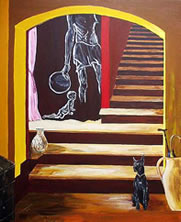Paintings with social and political sensitivity
by Makarand Sathe
‘Visual medium’ is a very effective medium for exchange of information. Today , however, it seems to be taking over our thinking by way of what we see with the help of new printing techniques. We are bombarded with images day and night by TV, computer, hoardings, photos in newspapers, etc….
One feels that the Indian society is not mature enough to appreciate paintings, sculpture and other visual arts. However, as mentioned above, visual media is quite successful in goading us to consumerism. Instead of enriching it, human mind is being taken over for commercial ends by the media. Rather than an exchange of thought, minds seem to get benumbed. Since this is basically a human interaction, wittingly or unwittingly it has political dimension as well.
Alongwith the visual medium, verbal language is another medium to establish communication between two persons. According to Chandrashekhar Purandare, today, language has lost its punch. The thoughts and feelings he wants to convey to others are not personal but are located in social and political context. These can be conveyed better through painting than through words. They can be understood better that way too, he feels. Anybody would agree that the visual medium is powerful not only in the negative sense mentioned above but also when used positively in a mature way. One is convinced of this experiment once one sees his paintings. That is why his attempts are worth welcoming.
Purandare’s paintings do not conform to the given notions of ‘painting’. He is not even formally trained as an artist. He is an engineer by profession. Almost 12 years after his graduation in engineering, he did his post-graduation in Sociology from the university of Pune. He is well conversant with many languages - German and Sanskrit alongwith Marathi, English and Hindi. He has had a sharp political awareness since early days. In 1977, while still a student, he went to Andhra Pradesh to study the Naxalite movement there. He wrote a series of articles on the findings in the marathi weekly ‘Manoos’. Later on he wrote a series of articles in Sunday Sakal on separatist movements in NorthEast India. Since 1995 he has been living in Britain. He started painting two/two-and-half years back.
As said, his paintings express social and political sensitivities. He has no doubts about efficacy of painting as a means of communication. At the same time he is not much bothered about the aesthetics of it. In his own words, his paintings ‘ mainly depict social and political misery. Man-made poverty, inequality, violence kill thousands of people all over the world…..My paintings are not an expression of beauty……The definition of beauty presumes delicacy, subtlety, ambiguity….These paintings do not fit into this definition. People starve to death, kill other people, trudge miles everyday the whole life for drinking water….there is nothing delicate, subtle or ambiguous about it.’
This underlying premise comes across very clearly in Purandare’s paintings. I find his paintings important in the cleft we are in – on the one hand immature sensitivity to paintings, and , on the other, facing the onslaught of images arising out of consumerism. Many times his paintings use the images from newspapers or advertisements for political commentary. He unravels the daily assault of images and shows us the underlying different meanings or the subtext.
Let us not get into the futile debate of – whether to call these ‘painting’ at all or not. Let us see them with a fresh mind. They will enrich us.
I am sure his exhibition will be of interest not only to the keen observers of visual arts but to all others.
[Translation of the original article in Marathi, a regional Indian language, published in ‘Sakal’ a leading daily newspaper in Maharashtra, India on Dec 16, 2004]
